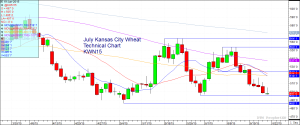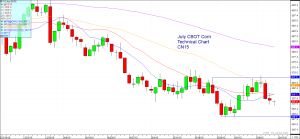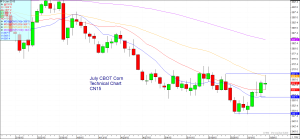A big day this morning at Farmer’s Coop Elevator as wheat had rallied $0.23 in the early morning hours last night. The first few hours of trade after the opening bell saw corn up $0.13 and wheat up $0.25. Both managed to trade and close above some strong resistances at their respective 100-day moving averages. This is a good sign and indication that prices could rally higher in the near future. Farmer’s Coop Elevator had one of the better business days since I have started.
Overall, the week was good for both corn and wheat. We started out with a rally in both commodities that was attributed to short covering. Just as the traditional 3-day short covering rally was starting to end, prices found a second wind. Trade is beginning to have an attitude change about exactly how beneficial excessive moisture is in making grain. Quality reductions are a concern for corn in parts of the corn belt that are seeing some tremendous amounts of rain. The corn condition report on Monday confirmed this concern with the good to excellent rating dropping 2% from last week. This spurred a second rally in corn which pulled wheat along with it supported by declining soft red winter wheat condition and short covering of fund contracts. The week ended well with wheat up a total of $0.56 for the week and corn up $0.31.
The USDA second quarter stocks and acreage report is released on June 30. Trade is currently debating final corn acreage. Some argue that due to excessive moisture and early severe storms, the corn acre estimate is too high and will need to be reduced. Others argue that acres were severely under-estimated in the first quarter, March 31 report and that acreage will remain the same or increase. Well followed Informa left their acreage estimate unchanged in their report last Friday. It is unlikely that this debate will be resolved until next Tuesday and could be supporting the current rally.
There is still a lot of old crop bushels being stored but the recent rally has spurred some producer selling which has caused basis to weaken across the corn belt. We are nearing July 4th which has historically been a primary marketing point of the year. The consensus is that if there has been no significant stress on a crop by July 4th then it is made. This is mostly psychological and we can very easily see some late season stress on crops, especially in 2010 which is what this year is being compared to for weather.
Wheat has been in a sideways trend of about 70-80 cents since mid-April in which it has made about 3 cycles between the high and the low. The high of those cycles just barely touches $5.00 cash price in Hemingford which is near our closing price today. Kansas harvest reports suggest better-than-expected wheat quality. They report average yields, test weights, and protein levels despite previous concern over lower test weights and protein due to excessive moisture.












You must be logged in to post a comment.